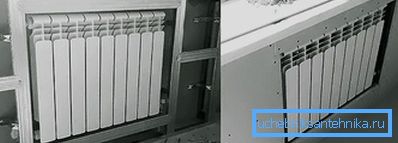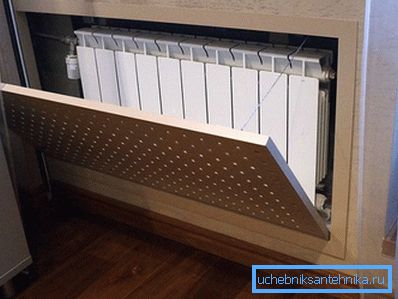How to close the radiator in the room?
The appearance of a heating radiator is far from the aesthetic look that residents expect. Therefore, many people are interested in how to close the radiator in the room or in the kitchen. However, before this, it is necessary to determine how expedient this solution is, since the heat emission may decrease due to an incorrectly installed structure.
Decor

Before you start to frantically search, rather than close the radiator, you should try alternative methods:
- Curtain. To close the cotton curtain is quite suitable. True, there is one limitation: in this way you can close only the product that is located in the niche. An alternative option is blinds.
- Decoupage Ordinary napkins and PVA glue is another way to decorate a heating element. This work can be done by hand, and special skills and expensive material is not required. You just need to choose napkins of a suitable color, cut out of them several necessary elements and paste over the device with them. On top of the decor should be applied several layers of special heat-resistant varnish.
- Painting. Sometimes it is enough to remove the old coating during repairs and apply a new paint on the surface. This will require a special paint composition, which is not afraid of exposure to high temperatures. When selecting colors should be based on the overall tone of the interior.
Painting is appropriate if modern aluminum batteries are installed in the room, as the painted cast iron product will be very noticeable. The radiator does not have to be monotonous, the use of different patterns is also possible. If the artistic skill is not available, then you can resort to using a special stencil.
Ways to close the heating battery

If decorating the heater for any reason failed, you can try to hide it behind a special grille or perforated screen. For the manufacture of such devices, you can use a variety of materials, and a variety of shapes and designs will pleasantly surprise anyone.
Making the screen, do not forget about such an important point as perforation, since it depends on how much heat will flow into the room.
The presence of solid side and upper slats adversely affects the efficiency of heat transfer.

You can try to hide the heater behind the drywall. At the preparatory stage, measurements are taken, the amount of material required and the method of finishing are determined. Now you can proceed to the choice of drywall. Widely popular this building material owes its environmental friendliness. Since the finish is an important aesthetic stage, you should pay attention to the variety of shades and colors. Masking the battery can be carried out both ceiling and wall plasterboard.
Making the frame is the most crucial step, so there can not be dispensed with level or plumb. For the manufacture of the frame, you can use a profile or tree (the second option is more simple). Fixing the rail on the floor should be done with liquid nails or screws. To mount the bottom panel of the window, you will need a profile of 60? 27 mm. Now you need to fasten a few horizontal jumpers - profile 60.
Drywall is a fairly durable material, so install extra lintels are not worth it.
You can trim the attachment points with the help of the furniture edge. When the installation of all necessary parts is complete, you can proceed to the filler and painting. Paint can be replaced with wallpaper or adhesive film, the most similar to the general interior. For finishing the radiator is better to use moisture-resistant drywall. The fact is that the surface of the heating radiator may be periodically covered with condensate, for example, when the heating is temporarily turned off during the cold season.
When building the top cover, hiding the radiator, it is important to consider how it will open. Thus, you not only prevent the appearance of another dust collector in the house, but also provide easy access to the radiator in case of unplanned repairs. Remember that drywall does not belong to the category of durable materials, which means that you need to ensure its careful operation.
The negative side of drywall is fragility, as well as exposure to water and possible deformation. But he has much more advantages. Among them it is worth noting:
- ecological cleanliness;
- low flammability level;
- availability;
- the opportunity to realize any design idea.
So, there are a lot of options for closing the heater. When choosing it is important to be guided by personal preferences and financial capabilities. Above all, remember that at the same time the heat transfer of the batteries should be preserved, and the appearance of the decor should be in harmony with the general interior of the room or kitchen.
Video
How to assemble a decorative box? You will find a complete answer to this question in the video:
A photo




